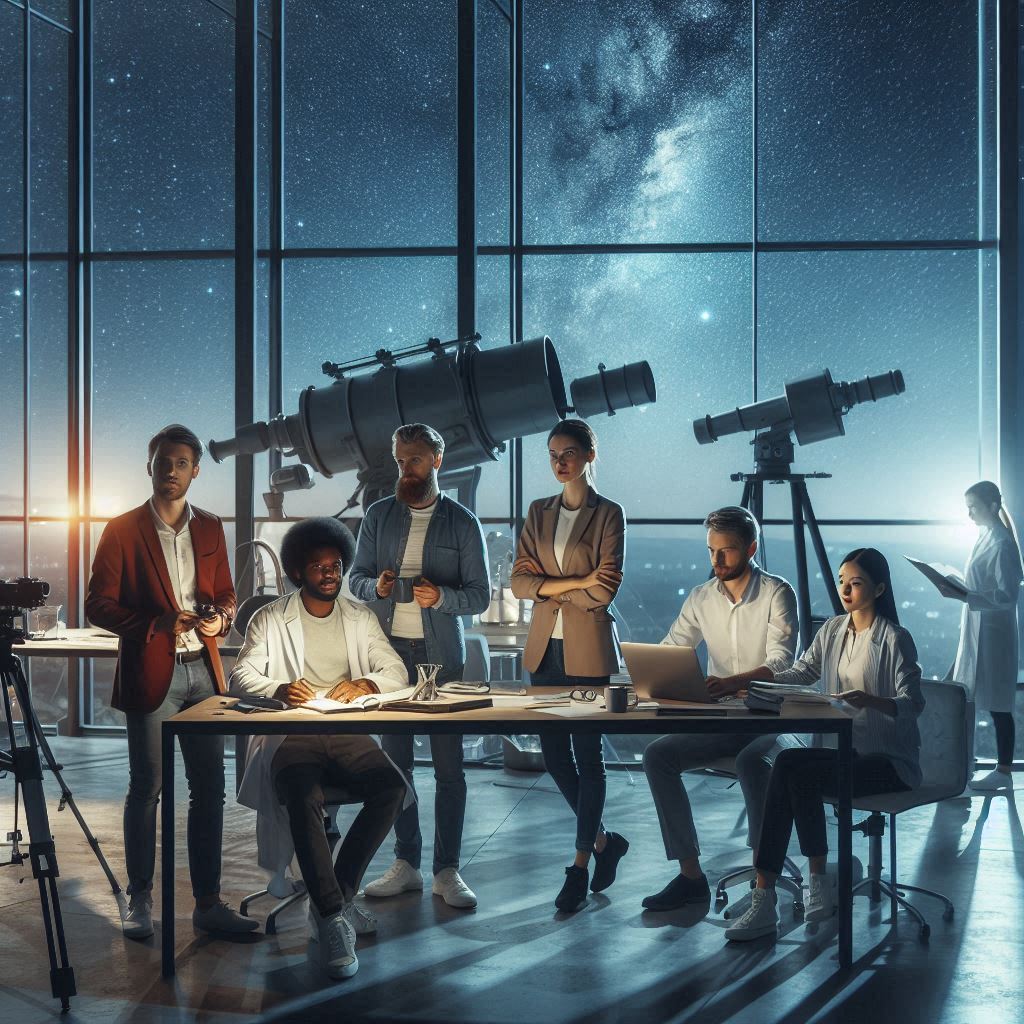Introduction
Telescopes play a crucial role in astronomy.
They allow astronomers to observe celestial objects far beyond human sight.
By gathering light from distant stars and galaxies, telescopes enable us to explore the universe.
Their importance in expanding our understanding of space cannot be overstated.
Without telescopes, we would miss essential details about our cosmic neighborhood.
Astronomers use various types of telescopes, each serving a unique purpose.
Optical telescopes capture visible light, revealing intricate details of celestial bodies.
Radio telescopes detect radio waves, allowing scientists to study objects invisible to optical telescopes.
Infrared telescopes observe heat emitted by cosmic objects, unveiling information about star formation and the evolution of galaxies.
Each telescope type contributes to a broader understanding of the universe.
Telescopes function by collecting and magnifying light from distant objects.
The primary mirror or lens captures incoming light, focusing it into a single point.
This process enhances the brightness and clarity of the observed object.
Astronomers then use various instruments to analyze the collected light.
They can measure the object‘s brightness, color, and spectrum, unlocking vital information about its composition and distance.
History of telescopes in astronomy
The Invention of the First Telescopes
The history of telescopes in astronomy traces back to the early 17th century.
In 1608, Dutch eyeglass maker Hans Lippershey invented the first practical telescope.
His simple device used two lenses to magnify distant objects.
Though initially intended for military use, the telescope quickly found its place in science.
In 1609, Galileo Galilei, an Italian astronomer, improved Lippershey’s design.
He constructed a more powerful telescope and directed it at the night sky.
Galileo‘s discoveries, including the moons of Jupiter and the phases of Venus, revolutionized astronomy.
His work demonstrated that telescopes could reveal celestial bodies in unprecedented detail.
Evolution of Telescopes Over Time
As telescopes gained popularity, their designs became more sophisticated.
In 1668, Isaac Newton invented the first reflecting telescope, which used mirrors instead of lenses.
This innovation reduced distortions and allowed for clearer images of distant stars and planets.
Reflecting telescopes became the preferred design for astronomers due to their superior performance.
Throughout the 18th and 19th centuries, telescope technology advanced rapidly.
William Herschel, a British astronomer, built a giant reflecting telescope in 1789.
With it, he discovered Uranus, expanding humanity‘s knowledge of the solar system.
Larger and more powerful telescopes allowed astronomers to observe objects beyond the reach of earlier models.
By the 20th century, telescopes had evolved even further.
The construction of the Mount Wilson Observatory in California marked a major milestone.
Its 100-inch Hooker telescope, completed in 1917, enabled astronomer Edwin Hubble to observe distant galaxies.
Hubble‘s observations proved that the universe is expanding, reshaping our understanding of the cosmos.
Impact of Telescopes on Our Understanding of the Universe
The impact of telescopes on astronomy has been profound.
Before their invention, human understanding of the universe was limited to what could be seen with the naked eye.
Telescopes opened a new window to the universe, revealing planets, stars, and galaxies previously invisible.
They provided the means to study celestial objects in greater detail and transformed our knowledge of space.
Modern telescopes, such as the Hubble Space Telescope, have taken astronomy to new heights.
Launched in 1990, Hubble orbits Earth and captures images of distant galaxies, nebulae, and black holes.
Its observations have led to groundbreaking discoveries, including evidence of dark energy and exoplanets.
In short, the invention and evolution of telescopes have revolutionized astronomy.
Telescopes have expanded our view of the universe, deepening our understanding of its structure, origins, and vastness.
They continue to play a crucial role in unraveling the mysteries of the cosmos and shaping modern astronomical research.
Types of telescopes used by astronomers
Reflecting telescopes
Reflecting telescopes use mirrors to collect and focus light for observation.
The primary mirror reflects light to a secondary mirror which directs it to the eyepiece.
These telescopes are typically larger in size and can gather more light.
They are ideal for observing distant celestial objects such as galaxies and nebulae.
Refracting telescopes
Refracting telescopes use lenses to bend and focus light for observation.
These telescopes have a long tube with lenses at each end.
They are often used for viewing planets, stars, and the Moon.
Refracting telescopes are simple in design but can provide clear and sharp images.
Radio telescopes
Radio telescopes detect radio waves emitted by celestial objects in space.
These telescopes have large dish antennas that collect radio signals.
They are used to study objects that emit radio waves, such as pulsars and quasars.
Radio telescopes can detect objects that are not visible in optical light.
Space telescopes
Space telescopes are placed in orbit around the Earth or other celestial bodies.
These telescopes are free from the distortion caused by Earth’s atmosphere.
They can observe a wide range of wavelengths, including X-rays and ultraviolet light.
Space telescopes have provided valuable data on the universe beyond what ground-based telescopes can offer.
Transform Your Career Today
Unlock a personalized career strategy that drives real results. Get tailored advice and a roadmap designed just for you.
Start NowIn general, astronomers use a variety of telescopes to study the universe. Each type has its own advantages and is used for specific purposes.
From reflecting telescopes to space telescopes, these instruments provide valuable insights into the cosmos.
Read: Essential Skills and Tools for Modern Chemists in America
How Telescopes Collect and Focus Light
Telescopes play a crucial role in astronomy.
They collect and focus light from distant celestial objects.
This process enhances our ability to observe the universe.
Understanding how telescopes work begins with their optics.
Optics of Telescopes
Telescopes use optical components to gather light.
They employ either lenses or mirrors to form images.
The primary lens or mirror collects incoming light and focuses it.
This light is then directed to an eyepiece or camera.
The design of these components greatly influences image quality.
Mirror or Lens Systems
There are two main types of telescopes: refractors and reflectors.
Refractors use lenses to bend light.
They have a primary lens at the front, which gathers light.
This light converges to a focal point, creating a clear image.
Reflectors, on the other hand, utilize mirrors.
They feature a curved mirror that collects and focuses light.
This design minimizes optical distortions and allows for larger apertures.
The size of the aperture is essential for light collection.
A larger aperture allows telescopes to capture more light.
This increases the brightness of the images.
Consequently, astronomers can observe fainter objects in the sky.
Telescopes with larger apertures also provide better resolution.
This means they can reveal finer details in celestial bodies.
Importance of Precise Focusing for Clear Images
Focusing light accurately is critical for clear images.
If the light is not perfectly focused, the image appears blurry.
Astronomers carefully adjust the focus to achieve clarity.
They use fine-tuning mechanisms for precise adjustments.
These adjustments ensure that the telescope delivers sharp, detailed images.
The quality of the optics also affects image clarity.
High-quality lenses and mirrors reduce aberrations.
These aberrations can distort the appearance of celestial objects.
Astronomers often use coatings on lenses and mirrors.
These coatings improve light transmission and reduce reflections.
This results in brighter and clearer images.
In addition to optical quality, telescope design impacts light collection.
The arrangement of lenses and mirrors affects how light travels through the system.
Designers aim for optimal light paths to maximize efficiency.
Some telescopes use multiple mirrors to gather light from various angles.
This design enhances their capability to observe different wavelengths.
Generally, telescopes collect and focus light using sophisticated optics.
They utilize mirror or lens systems to create images.
Precise focusing is essential for producing clear images.
The combination of large apertures and high-quality optics enables astronomers to study the universe effectively.
Through these powerful instruments, we gain invaluable insights into the cosmos.
Read: The Role of Chemists in US Environmental and Sustainability Efforts

Techniques astronomers use with telescopes
Astronomers use various techniques with telescopes to explore the universe and understand its vast complexities.
Below are four key methods astronomers rely on to gather valuable data.
Imaging
One common technique is imaging, which captures detailed photographs of celestial objects.
Using imaging, astronomers observe planets, stars, galaxies, and nebulae to study their structure and behavior.
They often apply filters to isolate specific wavelengths of light, revealing details invisible to the naked eye.
Imaging also allows astronomers to track changes over time, providing insight into dynamic processes like star formation, supernovae, and galaxy evolution.
Spectroscopy
Spectroscopy is another essential technique used with telescopes.
This method involves splitting light from celestial objects into its component wavelengths, much like a prism creates a rainbow.
By analyzing these spectra, astronomers identify the chemical composition, temperature, and velocity of stars and galaxies.
Spectroscopy helps determine if a star is moving toward or away from Earth through a phenomenon known as the Doppler effect.
This technique has been pivotal in discovering exoplanets, measuring the expansion of the universe, and understanding the life cycles of stars.
Photometry
Photometry measures the brightness of astronomical objects over time.
By studying the variations in brightness, astronomers can learn about the size, distance, and energy output of stars and other celestial bodies.
Photometry is particularly useful for identifying variable stars, which change in brightness due to internal or external factors.
It also plays a critical role in detecting exoplanets, as the slight dimming of a star‘s light can indicate the presence of a planet passing in front of it.
Astrometry
Astrometry focuses on measuring the precise positions and movements of celestial objects.
This technique helps astronomers map the stars and track their motion across the sky.
Astrometry is essential for understanding the dynamics of star systems and the structure of our galaxy.
It also contributes to the discovery of nearby planets by detecting the subtle wobble in a star’s position caused by the gravitational pull of an orbiting planet.
Together, these techniques‘imaging, spectroscopy, photometry, and astrometry‘allow astronomers to gather a wide range of data.
They help scientists explore the universe‘s vast distances, uncover the mysteries of distant galaxies, and search for planets beyond our solar system.
Each method provides unique insights, enabling astronomers to piece together a more comprehensive understanding of the cosmos.
The continued development of telescopic technologies will further enhance these techniques, opening new doors to the mysteries of the universe.
Read: Day in the Life: An Environmental Scientist‘s Typical Day
You Might Also Like: Day in the Life of a Forensic Scientist
Examples of groundbreaking discoveries made with telescopes
Astronomers have made groundbreaking discoveries using telescopes, unveiling some of the universe‘s greatest mysteries.
Exoplanets
One of the most significant breakthroughs involves the discovery of exoplanets.
With telescopes like the Kepler Space Telescope, astronomers have identified thousands of planets outside our solar system.
These discoveries have revolutionized our understanding of planetary systems and the possibility of life beyond Earth.
Exoplanets were once hypothetical, but now they are concrete evidence of planetary diversity.
By observing the light from distant stars, astronomers can detect tiny dips in brightness, which suggest a planet is orbiting the star.
This method, called the transit method, has helped discover exoplanets in the habitable zones of stars.
These are regions where liquid water might exist, making the planets potentially suitable for life.
Black Holes
Telescopes have also played a vital role in revealing the nature of black holes.
Once considered purely theoretical, black holes are now well-documented cosmic phenomena.
The Event Horizon Telescope (EHT) produced the first-ever image of a black hole in 2019.
This groundbreaking achievement confirmed Einstein’s theory of general relativity and gave us a glimpse into the most extreme environments in the universe.
Black holes are regions of space where gravity is so strong that nothing, not even light, can escape.
By observing how matter behaves near black holes, telescopes have helped scientists understand their properties.
These discoveries have advanced our knowledge of how black holes influence galaxies and the universe‘s structure.
Galaxies
Galaxies themselves have been extensively studied through telescopes.
The Hubble Space Telescope has provided detailed images of galaxies billions of light-years away.
These observations have allowed astronomers to study galaxy formation, evolution, and interactions.
By analyzing the light from distant galaxies, astronomers can look back in time and understand how the universe has evolved.
Cosmic Microwave Background Radiation
Another groundbreaking discovery made with telescopes is the cosmic microwave background radiation (CMB).
The CMB is the faint glow left over from the Big Bang, providing evidence of the universe’s origins.
Telescopes like the Planck satellite have mapped the CMB with incredible precision.
This radiation is the oldest light in the universe, offering astronomers a glimpse into the universe‘s infancy, around 380,000 years after the Big Bang.
The CMB’s discovery has confirmed the Big Bang theory and helped refine models of the universe’s expansion.
Through this radiation, telescopes provide a direct link to the early universe, allowing scientists to study its formation and development.
Telescopes have transformed our understanding of the cosmos, leading to groundbreaking discoveries.
From exoplanets and black holes to galaxies and cosmic microwave background radiation, telescopes continue to unlock the universe‘s secrets.
Transform Your Career Today
Unlock a personalized career strategy that drives real results. Get tailored advice and a roadmap designed just for you.
Start NowRead: The Impact of Technology on the Chemist Profession in the US
Learn More: Work-Life Balance in the Pharmacology Profession
Challenges astronomers face when using telescopes
Astronomers face several challenges when using telescopes to study the universe.
These obstacles range from environmental issues to technical limitations, all of which affect the quality and accuracy of observations.
Light Pollution
One major challenge is light pollution, which hampers the clarity of observations.
Urban and artificial lighting obscure celestial objects, making it difficult to capture faint light.
To counter this, astronomers often build observatories in remote locations away from cities.
Even with this effort, controlling light pollution remains a significant challenge.
Atmospheric Distortion
Atmospheric distortion is another problem astronomers face when using ground-based telescopes.
Earth’s atmosphere causes the light from stars and galaxies to bend, blur, and flicker.
This effect, known as “seeing,” reduces the precision of observations.
To minimize atmospheric interference, astronomers often use adaptive optics.
These systems adjust the telescope‘s mirrors in real time to correct for atmospheric distortion.
However, this technology is not perfect and cannot fully eliminate the effects of the atmosphere.
Instrumental Limitations
Astronomers also face instrumental limitations when using telescopes.
Telescopes, no matter how advanced, have restrictions in their size and capabilities.
Larger telescopes can capture more light, but they require precise engineering and are expensive to build.
Space telescopes, while free from atmospheric distortion, face the challenge of maintenance and repairs.
The Hubble Space Telescope, for example, needed multiple service missions to correct its initial optical flaw.
These limitations make it difficult for astronomers to gather data from distant or faint celestial objects.
Data Processing and Interpretation
Data processing and interpretation pose further challenges for astronomers.
Modern telescopes capture vast amounts of data, often in multiple wavelengths.
Astronomers must process this data to produce images or spectra for analysis.
However, the sheer volume of data requires complex algorithms and powerful computing systems.
Misinterpretation of data can lead to inaccurate conclusions about the nature of celestial objects.
Additionally, noise in the data from instrumental or environmental sources complicates the analysis, making it harder to extract clear information.
Moreover, astronomers must also contend with cosmic interference, such as radio signals from human-made satellites and other sources.
This interference can distort or obscure observations, particularly in radio astronomy.
Filtering out these unwanted signals requires advanced techniques, adding to the complexity of the process.
Basically, astronomers face several challenges when using telescopes, including light pollution, atmospheric distortion, instrumental limitations, and data processing difficulties.
These challenges require innovative solutions and continuous advancements in technology.
Despite these obstacles, astronomers have made tremendous strides in understanding the universe, and ongoing improvements in telescope design and data analysis promise even greater discoveries.
Overcoming these challenges is essential to further expanding our knowledge of the cosmos.
Conclusion
Telescopes have revolutionized astronomy by enabling scientists to observe distant objects in the universe.
They provide critical insights into celestial bodies, helping astronomers understand cosmic phenomena.
By capturing light from stars, galaxies, and other distant objects, telescopes reveal the universe‘s history and structure.
Without these powerful tools, our knowledge of space would be severely limited.
Through telescopes, astronomers have discovered planets outside our solar system, detected black holes, and mapped the cosmic microwave background.
These discoveries have expanded our understanding of the universe‘s origins and evolution.
Telescopes also help scientists study the life cycles of stars and the movement of galaxies.
This ability to observe far-reaching objects has transformed astronomy into a data-rich field.
There are different types of telescopes, each offering unique advantages.
Optical telescopes allow scientists to observe visible light, providing clear images of planets and stars.
Radio telescopes, on the other hand, capture radio waves, helping astronomers study phenomena like pulsars and quasars.
Infrared telescopes can observe objects that are too faint or cold to emit visible light, revealing hidden aspects of the universe.
Each of these tools has contributed significantly to modern astronomical research.




